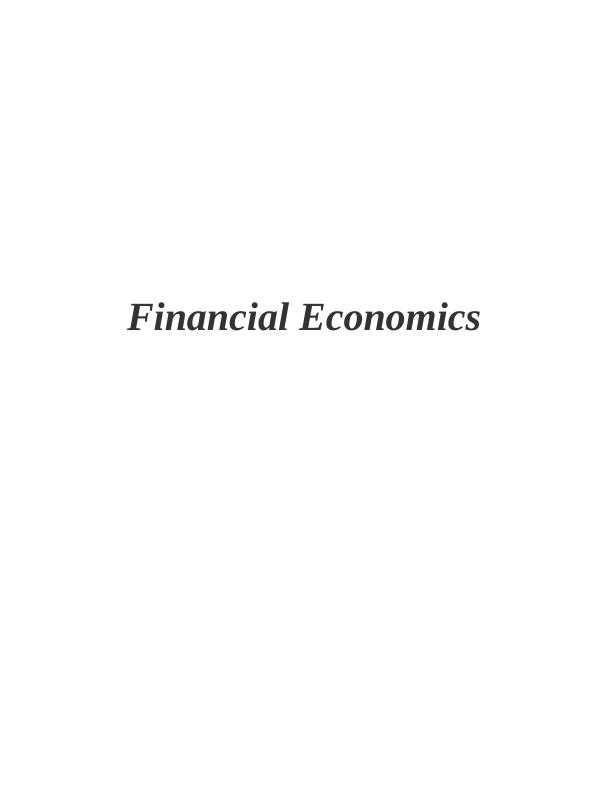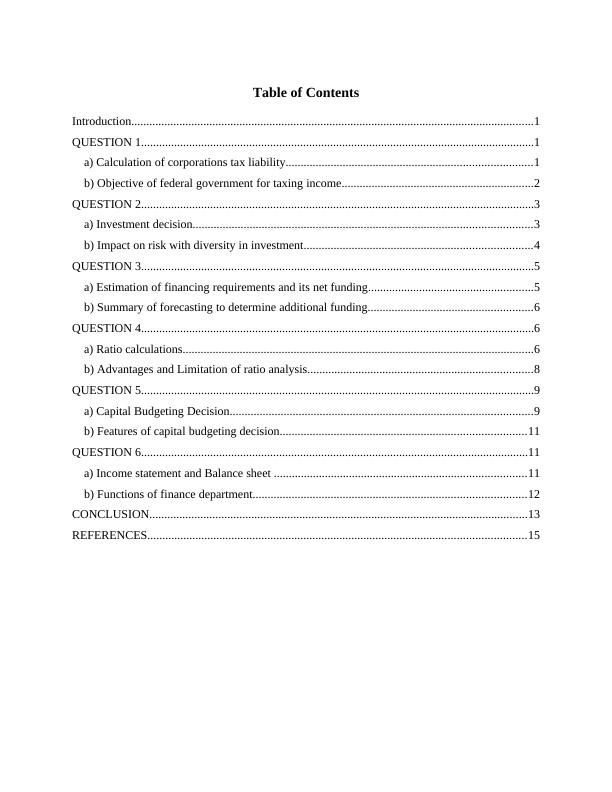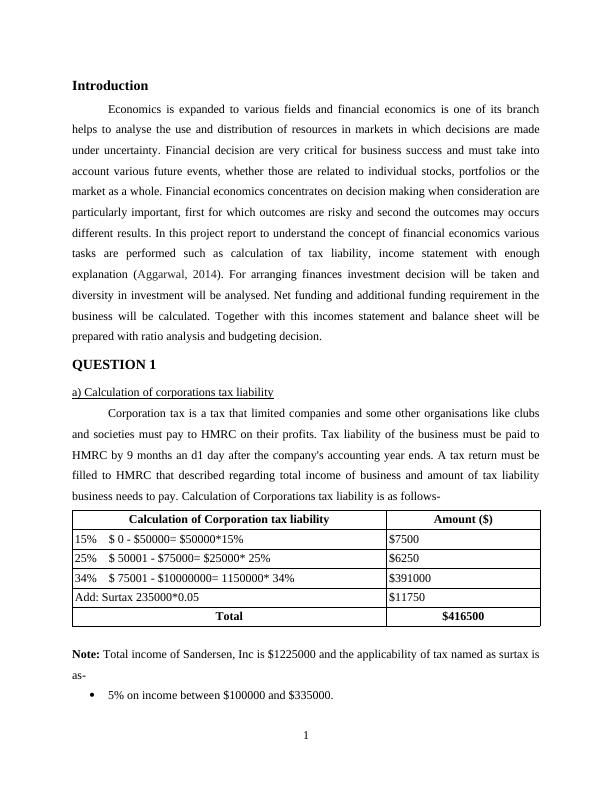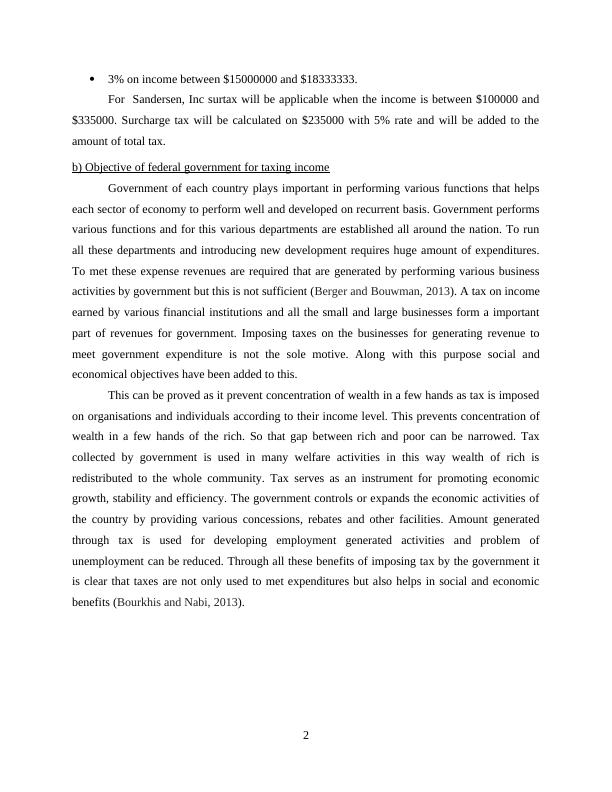Financial Economics - PDF
17 Pages4487 Words449 Views
Added on 2020-11-12
Financial Economics - PDF
Added on 2020-11-12
ShareRelated Documents
Financial Economics

Table of ContentsIntroduction......................................................................................................................................1QUESTION 1...................................................................................................................................1a) Calculation of corporations tax liability..................................................................................1b) Objective of federal government for taxing income................................................................2QUESTION 2...................................................................................................................................3a) Investment decision.................................................................................................................3b) Impact on risk with diversity in investment............................................................................4QUESTION 3...................................................................................................................................5a) Estimation of financing requirements and its net funding.......................................................5b) Summary of forecasting to determine additional funding.......................................................6QUESTION 4...................................................................................................................................6a) Ratio calculations.....................................................................................................................6b) Advantages and Limitation of ratio analysis...........................................................................8QUESTION 5...................................................................................................................................9a) Capital Budgeting Decision.....................................................................................................9b) Features of capital budgeting decision..................................................................................11QUESTION 6.................................................................................................................................11a) Income statement and Balance sheet ....................................................................................11b) Functions of finance department...........................................................................................12CONCLUSION..............................................................................................................................13REFERENCES..............................................................................................................................15

IntroductionEconomics is expanded to various fields and financial economics is one of its branchhelps to analyse the use and distribution of resources in markets in which decisions are madeunder uncertainty. Financial decision are very critical for business success and must take intoaccount various future events, whether those are related to individual stocks, portfolios or themarket as a whole. Financial economics concentrates on decision making when consideration areparticularly important, first for which outcomes are risky and second the outcomes may occursdifferent results. In this project report to understand the concept of financial economics varioustasks are performed such as calculation of tax liability, income statement with enoughexplanation (Aggarwal, 2014). For arranging finances investment decision will be taken anddiversity in investment will be analysed. Net funding and additional funding requirement in thebusiness will be calculated. Together with this incomes statement and balance sheet will beprepared with ratio analysis and budgeting decision. QUESTION 1a) Calculation of corporations tax liabilityCorporation tax is a tax that limited companies and some other organisations like clubsand societies must pay to HMRC on their profits. Tax liability of the business must be paid toHMRC by 9 months an d1 day after the company's accounting year ends. A tax return must befilled to HMRC that described regarding total income of business and amount of tax liabilitybusiness needs to pay. Calculation of Corporations tax liability is as follows- Calculation of Corporation tax liabilityAmount ($)15% $ 0 - $50000= $50000*15%$750025% $ 50001 - $75000= $25000* 25%$625034% $ 75001 - $10000000= 1150000* 34%$391000Add: Surtax 235000*0.05$11750Total$416500Note: Total income of Sandersen, Inc is $1225000 and the applicability of tax named as surtax isas- 5% on income between $100000 and $335000.1

3% on income between $15000000 and $18333333. For Sandersen, Inc surtax will be applicable when the income is between $100000 and$335000. Surcharge tax will be calculated on $235000 with 5% rate and will be added to theamount of total tax. b) Objective of federal government for taxing incomeGovernment of each country plays important in performing various functions that helpseach sector of economy to perform well and developed on recurrent basis. Government performsvarious functions and for this various departments are established all around the nation. To runall these departments and introducing new development requires huge amount of expenditures.To met these expense revenues are required that are generated by performing various businessactivities by government but this is not sufficient (Berger and Bouwman, 2013). A tax on incomeearned by various financial institutions and all the small and large businesses form a importantpart of revenues for government. Imposing taxes on the businesses for generating revenue tomeet government expenditure is not the sole motive. Along with this purpose social andeconomical objectives have been added to this. This can be proved as it prevent concentration of wealth in a few hands as tax is imposedon organisations and individuals according to their income level. This prevents concentration ofwealth in a few hands of the rich. So that gap between rich and poor can be narrowed. Taxcollected by government is used in many welfare activities in this way wealth of rich isredistributed to the whole community. Tax serves as an instrument for promoting economicgrowth, stability and efficiency. The government controls or expands the economic activities ofthe country by providing various concessions, rebates and other facilities. Amount generatedthrough tax is used for developing employment generated activities and problem ofunemployment can be reduced. Through all these benefits of imposing tax by the government itis clear that taxes are not only used to met expenditures but also helps in social and economicbenefits (Bourkhis and Nabi, 2013). 2

End of preview
Want to access all the pages? Upload your documents or become a member.
Related Documents
Financial Management: Tax Liability, Risk and Returns, Financing Requirementslg...
|17
|4762
|50
Financial Management: Tax Liabilities, Risk & Return, Financial Statementslg...
|21
|4470
|34
Financial Managementlg...
|15
|3050
|28
Financial Management: Tax, Capital Budgeting and Financial Marketslg...
|11
|2744
|226
Financial Management: Leverage and Investment Appraisallg...
|19
|4217
|1
Financial Management Conceptslg...
|12
|1852
|77
